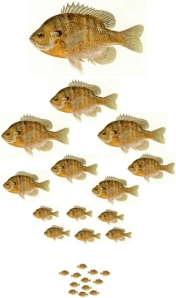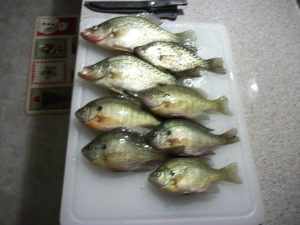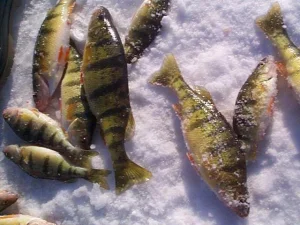Greedy fisherman = stunted fisheries? (part one)

In some circles, you're only a good fisherman if you can catch a limit of trophy slab crappie, bluegills, or super jumbo perch. In some, it's all about the numbers, how many pounds of fish you have put into the freezer. While in a very small minority, you get praise for returning those trophy fish back to the water after a few pictures and measurements.
Because of these views, we, as fishermen feel the need to pick sides on where we stand. Some make this choice based on peer pressure, others from misguided advice, and a select few, keep an open mind and learn and evolve their views as information is presented. No matter which category you find yourself in, we will always have one thing in common, the ambition to catch large fish. So how do we as fishermen cure the problem of stunted fisheries?
Sure, it is easy for us to point a finger at management and pass the buck. "It's all the DNR's fault they are to blame for all of these 4-inch bluegills I catch every time I go out fishing". "It's the guys who keep too many fish every time they go out". To tell you the truth I could fill volumes with reasons and who to point the finger at. Doing that will not solve a darn thing. What we need to start doing is talking about how we as a group can fix this. That includes the DNR, USFW, the Outdoor Industry, and even the poorest of poor fishermen. But before we can start to fix the problem we all have to understand the reasons why we have stunted fisheries. Most stunted fisheries today are not caused by natural phenomena, they're caused by human phenomena. When you remove too many of a certain class of fish you are setting the lake up for stunting.
Let me explain this idea further to you.

In any given body of water, you have a certain amount of fish it can support, this is commonly referred to as biomass in the lake. The total biomass should be set up in the shape of a pyramid, where every level is just large enough to support the next level up the pyramid (this is mass ie weight not the number of fish). At the bottom of the pyramid, you have a baseline food source, such as Benthos. Benthos encompasses microorganisms, mussels, aquatic insects, etc. On the next level, we have food fish, which are minnows and young of the year. On the next level, you have low-level predators these will feed on everything in the lower two levels the benthos and small fishes. Above that, you have mid-level predators which feed on the two levels below it. By now I am sure you get the point. This is a basic concept that even grade school children will understand. The primary factor in stunted fish is “food sources” at different stages in life and growth.
Reproduction is next in line. In a given body of water, there is a very limited amount of spawning habitat. That habitat can only support so many spawning fish. Now, that number is solely dependent on the size of fish that is within a given system. Those larger spawning fish will command more spawning room and spread out further in the prime spawning grounds. This is nature's way of controlling how many fish can successfully breed in a given system. This in turn will keep year classes in check and level most years. There will be some years when a body of water will have a bummer year class, and it happens.

So what happens when you remove one of those breeders out of the system? If you remember above I mentioned something called biomass. If you take, say a 10-inch blue gill, out of a lake, something is going to take its place. That will generally be a few smaller fish equal to that fish's biomass. Within each fish species in a body of water, you have a range of sizes.
The best way to think of the different sizes is like a diamond. In a healthy system, at either end of the diamond, you will have extremes of size related to one another. Now, if you were to remove the fish that are at the top of that diamond you begin to see the diamond widen. You will start to see more and more fish in the mid-size class breeding successfully. These mid-size class fish require less room to spawn cause of their size. Which in turn gives you more successful breeding every year.
When this happens too many years in a row you have an overabundance of smaller fish in the system and they begin to over-browse food sources. This begins to directly affect the fish during their early key growth stages. Which results in smaller fish. Now, if that body of water can not reproduce and recover at a high enough level every year, you could begin to see the biomass capacity begin to decline. Which means it will support fewer fish.
At this point, I haven't yet touched on genetics. I feel genetics are directly related to the top of the diamond within each fish species population. At the top of that diamond, you have the biggest, fastest, and strongest in the gene pool. If you hunt whitetails you may understand this. This plays a big part in growing larger specimens within a population. The best genes are found in the largest fish in the system. Remove enough of them on a constant basis and you will help produce fish that can not grow to larger sizes.

How can we manage our fisheries? Selective harvest! Again, this is something you whitetail hunters might understand. We have to limit what we take and the size we take them at. This is where things get very complicated with fish. All species have different year classes that are their prime spawners. It is not always the largest fish. Take walleye for example, even though a large 10 lb plus female may have more eggs in her. She has a lower percentage of viable eggs. As she has aged she has lost the ability to produce quality eggs so we come back to the fact that she is so large she commands a larger area to spawn.
Knowing all of this, how do we go about selectively harvesting our catch? In a perfect world, each lake would be studied yearly. Bag and size limits would be set based on those studies. This could even mean a restriction on how much fishing pressure a given lake can have. But unfortunately, we do not live in a perfect world.
What is a fisherman to do? I personally believe, after studying this topic, I will continue doing mostly catch-and-release fishing. I do keep fish sometimes but that is usually to supply my father with a few fish dinners. He is getting up there in age and is getting harder and harder for him to go fishing and keep up. So what am I going to do is limit my catch when I do keep fish. This comes down to knowing the lake I am fishing.

Larger systems can generally handle a few more fish going home, and I do not have to be as selective with the fish I keep. Now on smaller bodies of water, maybe I would limit the amount of a certain size fish I can keep within my limit. Or maybe I will just cut my limit. Say, instead of keeping those 25 crappies I will only keep 15 or fewer fish.
Me doing that alone is just a drop in the bucket, and on the grand scale of things may not do much good. But if a group of fishermen starts to follow the same self-governing rules. That will begin to have a greater impact. Then they will spread that to other fishermen outside their group. Think of it as the 100 monkey theory. In that theory, you teach a small group of monkeys something, and soon one by one more and more monkeys will learn to do that. Monkey see monkey do! When you reach the “100th “ monkey, you have the entire population suddenly doing the same thing.
What I hope you all get out of this is if you want better fishing, get involved and educated. It's time we all begin to learn the lesson of real outdoor stewardship. We have lost sight of that in this rat-race, greed-hungry world.
Coming soon!
Part two Fixing fisheries that are stunted.
This was originally posted on my old blog Out In Michigan Feb 2011





